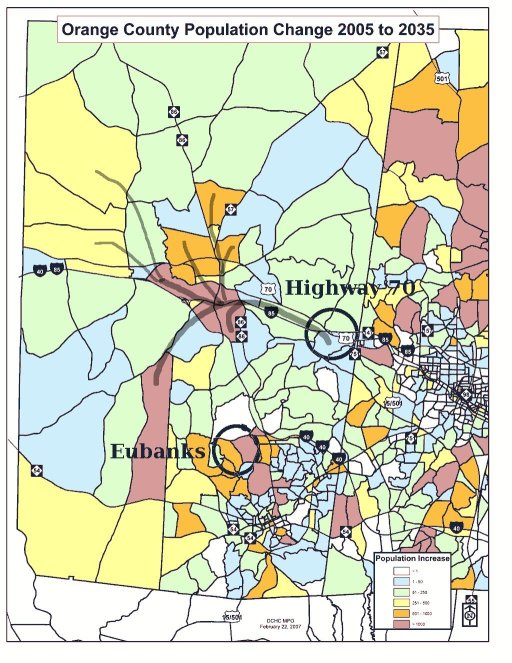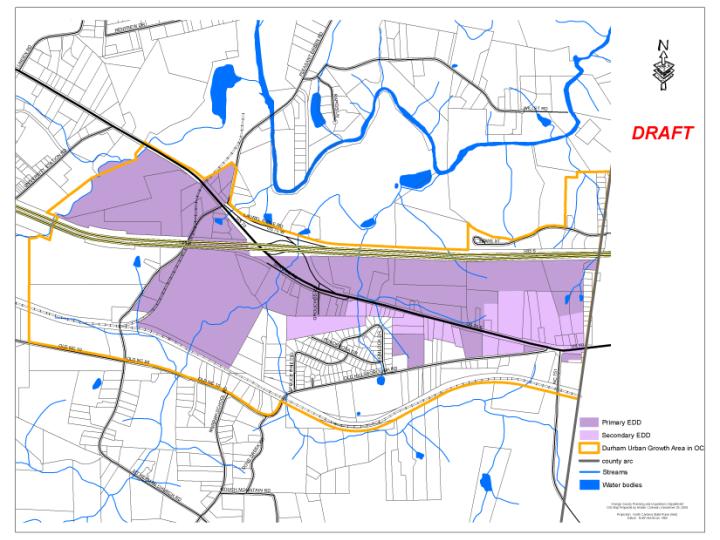[UPDATE:] Dan Coleman posted this nice summary over on OrangePolitics of the ’97 minutes:
Thanks, Mark. Your four points are absolutely correct. As well as reviewing the 1997 agreements, the Commissioner’s ought to take a close look at the landfill neighbors’ current “Hope Listâ€:
- 1) Cover open bed trucks going to landfill (agreed to in 1997 document)
- 2) Lower speed limit from 40 to 25 (issue with DOT)
- 3) Trash pick up along side Rogers Road (agreed to in 1997 document)
- 4) Site clean up and community assistance
- 5) Transit system for Rogers Road (promised in 1997, cost estimate for next FY requested last month)
- 6) Summer jobs for youth (15-19)
- 7) Sidewalks on both side of road (Carrboro is proceeding with study of its side)
- 8 ) Define county-wide goals as relate to Rogers Road communities
- 9) Recreation program in this community
I met with Reverend Campbell and Barbara Hopskin last week to discuss this list. It seems to convey a clear sense of what the neighborhood is looking for. I was struck by the extent to which these items are matters of common-sense, with many part of our regular processes for neighborhood improvements (improvements Rogers Road has waited on for far too long).
Thank you Dan for doing the heavy editing!
[ORIGINAL]
As I posted before, the Rogers Road community was supposed to receive value in trade for siting a landfill in their backyards.
During the Oct. 22nd, 1997, Assembly of Governments meeting (minutes [PDF] ) the following statements were made, reviewed, submitted to a vote and either passed or not.
First, these 5 key points of which each governmental body was asked to agree upon:
1. The County becomes the local government with primary authority and responsibility over operational and policy matters related to the solid waste system, subject to the limitations imposed by the Agreement.
2. In its capacity as the system operator, the County agrees to establish and maintain a new disposal facility, and in return for access to disposal capacities the Towns agree to provide their solid waste and recyclables to the County system.
3. The parties jointly agree on the location of that new disposal facility.
4. The parties agree on benefits or benefits processes related to the communities (a) in the area of the existing landfill and (b) in the area of the new disposal facility.
5. The parties agree on some treatment of the Greene Tract.
The following commitments were made:
ITEM FOURTEEN (xiv): This item reads as follows: The Working Group recommends that three residents of the area near the Eubanks Road landfill (two in the Rogers Road area, an one in the Millhouse Road area) be identified to receive all mailings and information sent to members of the Landfill Owners Group or its successor agency. This information should be made available to all residents of the area.
A motion was made by Council member Chilton, seconded to Alderman Gist, to approve this item as written.
VOTE: MOTION PASSED
Status: I’m not aware of the compliance with this directive.
ITEM TEN (x): This item reads as follows: The Working Group recommends that Chapel Hill Transit re-route the North-South connector bus line to serve Rogers Road on either its northbound or southbound trip, starting with the 1998-1999 service year. For the duration of the 1997-1998 service year, the Rogers Road area should be designated as a Shared Ride Feeder Zone if this can be accomplished within adopted budgets and available resources. [MY EMPHASIS]
Council member Franck stated that changing the bus route would be a “zero†cost option from a budgetary viewpoint. It will have a slight cost from a transit operation standpoint. This was not the first choice of Manager Cal Horton who recommended an alternative route.
A motion was made by Council member Franck, seconded by Alderman McDuffee, to approve Item Ten.
VOTE: Motion Passed
Status: Unmet due to various reasons. Brought up again during 2005 Chapel Hill election. Finally looks to be implemented.
This item reads as follows: The Working Group recommends that Orange County erect “Children Playing†and “School Bus Stop†signs on Rogers Road. Residents of the Rogers Road neighborhood will identify appropriate locations for these signs.
Commissioner Halkiotis asked if the Department of Transportation had declined this request.
Council member Chilton said that they had declined, however, the Town of Chapel Hill would provide these signs.
A motion was made by Council member Chilton, seconded by Alderman Gist, to approve this item as presented.VOTE: Motion Passed
Status: For several years I’ve heard complaints from Rogers Road citizens that the signage is not sufficient.
ITEM EIGHT (viii): This item reads as follows: The Landfill Owners Group will budget for the installation of perimeter fencing around the Orange Regional Landfill no later than the 1998-1999 Budget Year. Prior to completion of the fence, the Director of the Orange County APS shall be notified ,strong>to ensure that no large animals are trapped inside the fence.
Commissioner Gordon requested clarification regarding the concerns staff had about providing this perimeter fencing.
County Manager Link indicated that staff had questions about whether a 6’ fence was adequate given that deer could jump over a fence that high.
Council member Chilton stated that the neighbors were concerned about animals going into and out of the area, in particular dogs and vermin. The construction of a fence designed to control animals would be approximately $50,000 more expensive than the cost of the original fence which was approximately $150,000.
Commissioner Halkiotis suggested that the height and mesh needed to be adequate to keep out both vermin and deer.
A motion was made by Mayor Nelson, seconded by Alderman Gist, to approve this item as presented.
VOTE: Motion Passed
Status: Might’ve dealt with large animals getting out but the converse, keeping small animals like rats in, not complied with to the Rogers Road community’s satisfaction.
ITEM SEVEN (vii): This item reads as follows: The Working Group recommends that residents living near the Orange Regional Landfill take initiative in identifying perpetrators of illegal dumping near the landfill to assist in successful prosecutions. Identification of vehicles, license tags, drivers, and/or types of articles discarded should be made when possible.
The Landfill Owners Group will investigate with the Orange County Attorney the possibility of enacting legislation which would provide for civil penalties for illegal dumping, to make it easier to penalize people who litter. In addition, the LOG will publicize the names of those convicted of illegal dumping.
The Working Group recommends that additional “No Littering†signs be erected in the neighborhoods near the landfill.
A motion was made by Commissioner Carey, seconded by Alderman Gist, to approve Number Seven.
VOTE: Motion Passed
Status: A common complaint is that the current garbage transfer trucks produce a great amount of roadside litter. I’d be interested if anyone knows of haulers being cited for violating either local or state litter laws.
ITEM SIX (vi): This item reads as follows: The Landfill Owners Group will adopt a policy governing construction at the Orange Regional Landfill. This policy will govern issues affecting neighboring residents, including nighttime construction, blasting, and noise. The policy will identify ways to mitigate or eliminate adverse effects on landfill neighbors, and will require all neighbors (those living in the areas to be provided with water and sewer service) to be notified one week in advance of the start of construction. Such notification shall include the estimated duration of construction, and a description of any special construction activities which may impact neighbors. Notification will, at a minimum, include posting of signs on the four roadway entrances into these neighborhoods (the north end of Millhouse Road, both ends of Eubanks Road, and the south end of Rogers Road).
Under ordinary circumstances, the LOG and its contractors will avoid construction between the hours of 11:00 p.m. and 6:00 am and will provide for immediate notification of neighbors when emergency circumstances dictate that construction activities are unavoidable during these hours. The LOG will ensure that any contractors carrying out construction at the landfill follow the Orange County Noise Ordinance.
Council member Chilton stated that Chapel Hill staff’s assessment was that construction would most likely be happening all of the time, which would mean that signs would be posted all of the time.
A motion was made by Alderman Zaffron, seconded by Mayor Nelson, to approve Number Six of this agreement.
VOTE: Motion Passed.
Status: I remember complaints about construction noise when the landfill infrastructure was being modified/expanded during the early 2000’s. Not sure how the complaints were resolved.
I would hope that a similar provision would be adopted and ENFORCED if the transfer station is built on Eubanks.
ITEM FIVE (v): This item reads as follows: The Landfill Owners Group will adopt a policy which doubles the minimum frequency of litter pickup on roads surrounding the Orange Regional Landfill. This will result in litter pickup on Eubanks Road east of the landfill entrance at least twice weekly, on Eubanks Road west of the landfill entrance at least six times annually, and on Rogers Road at least eight times annually. Future modifications of these pickup frequencies shall be made only by the Landfill Owners Group or its successors.
A motion was made by Council member Franck, seconded by Alderman Zaffron, to approve this item.VOTE: Motion Passed.
Status: Roadside litter is a common complaint. I don’t recall any complaints on frequency – I hope to get a better read on this soon.
ITEM FOUR (iv): This item reads as follows: The Landfill Owners Group will adopt a policy which requires loads of mulch leaving the Orange Regional Landfill to be covered. The Landfill will make available for sale tarps of various sizes for purchasers of mulch to cover their loads. This policy will become effective after a three month grace period, during which time education will be provided to mulch purchasers at the landfill.
A motion was made by Alderman McDuffee, seconded by Council member Franck, to approve this item.
VOTE: Motion Passed
Status: From personal observation (based on several years of following trucks on Eubanks after exiting Millhouse) it seems that government-related loads of mulch are the most likely to be inadequately covered and blowing out. Not sure what the general compliance has been with this provision.
ITEM THREE (iii): This item reads as follows: The Landfill Owners Group will prepare and recommend a policy for adoption by the Chapel Hill Town Council which will require loads of waste (MSW and Construction and Demolition waste) being brought to the Orange Regional Landfill to be covered. Under the policy, loads which are not covered would be subject to fine. The fines would become effective after a three month grace period. Non-commercial first-time offenders should be offered the option of purchasing a tarp at the landfill in lieu of paying the fine.
Council Member Chilton stated that there is already a state law to this effect but it is not as stringent as this requirement would be.
A motion was made by Council member Pavao, seconded by Alderman Zaffron, to approve this item.
Status: Need more information. My personal observation is that compliance has slipped over the years as development has increased.
[UPDATE:] Carrboro Board of Aldermen Dan Coleman offers this succinct list of motions approved and defeated. From OrangePolitics:
ASSEMBLY OF GOVERNMENTS
OCTOBER 22, 1997
-
Item: three residents of the area near the Eubanks Road landfill (two in the Rogers Road area, an one in the Millhouse Road area) be identified to receive all mailings and information sent to members of the Landfill Owners Group or its successor agency.
Motion Passed
-
Item: no expansion (beyond the existing permitted disposal capacity) of the disposal areas (MSW or Construction and Demolition) of the Eubanks Road landfill occur.
The Working Group recommends that the Landfill Owners Group or its successor make no incremental land acquisitions at the Eubanks Road Landfill.MOTION FAILED
-
Item: following the closure of The Eubanks Road landfill, portions of the landfill (as allowed by regulations), the Neville tract, and at least 50 acres of the Green tract will be used for recreation facilities.
MOTION FAILED
-
Item: sponsor a public information meeting regarding the planning boundary (future annexation boundary) between Chapel Hill and Carrboro.
MOTION FAILED
-
Item: re-route the North-South connector bus line to serve Rogers Road on either its northbound or southbound trip, starting with the 1998-1999 service year
Motion Passed
-
Item: erect “Children Playing†and “School Bus Stop†signs on Rogers Road.
Motion Passed
-
Item: budget for the installation of perimeter fencing around the Orange Regional Landfill no later than the 1998-1999
Motion Passed
- Item: Investigate with the Orange County Attorney the possibility of enacting legislation which would provide for civil penalties for illegal dumping, to make it easier to penalize people who litter. In addition, the LOG will publicize the names of those convicted of illegal dumping.
-
Item: The Working Group recommends that additional “No Littering†signs be erected in the neighborhoods near the landfill.
Motion Passed
-
Item: policy will govern issues affecting neighboring residents, including nighttime construction, blasting, and noise. The policy will identify ways to mitigate or eliminate adverse effects on landfill neighbors
Motion Passed
-
Item: litter pickup on Eubanks Road east of the landfill entrance at least twice weekly, on Eubanks Road west of the landfill entrance at least six times annually, and on Rogers Road at least eight times annually.
Motion Passed
-
Item: requires loads of mulch leaving the Orange Regional Landfill to be covered. The Landfill will make available for sale tarps of various sizes for purchasers of mulch to cover their loads.
Motion Passed
-
Item: require loads of waste (MSW and Construction and Demolition waste) being brought to the Orange Regional Landfill to be covered.
Motion Passed
-
Item: water and sewer mains be extended to provide service to the area along the entire length of Rogers Road; Millhouse Road from Eubanks Road to New Jericho Road; and serving households on other side streets off these main roads (including, but not limited to Purefoy Drive, Rusch Road, Priscilla Lane, Sandberg Lane, Meadow Run Court, Manor Drive, Manor Court and Blackwood Mountain Road)
Motion Did Not Pass






